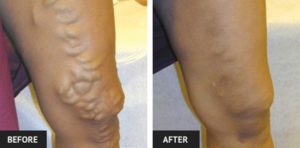By Joseph G. Magnant, MD, FACS, RPVI
 If you have been told by your doctor that your varicose veins are cosmetic or pose no immediate threat to you or that your swollen therapy until real “pain” occurred. With the modern, minimally invasive diagnostic technique of ultrasound and treatment options of endovenous ablation available for the past 18 years (since 2000) for the treatment of these patients’ problems, it is time to change the way we approach venous insufficiency.
If you have been told by your doctor that your varicose veins are cosmetic or pose no immediate threat to you or that your swollen therapy until real “pain” occurred. With the modern, minimally invasive diagnostic technique of ultrasound and treatment options of endovenous ablation available for the past 18 years (since 2000) for the treatment of these patients’ problems, it is time to change the way we approach venous insufficiency.
Many patients have been told by their primary care physicians that as long as their swollen, discolored legs don’t hurt they should leave them alone. Hypertension has earned the nick name of “the silent killer” due to the fact that many patients with high blood pressure are unaware of their condition until a screening blood pressure reveals a high reading. Untreated or undiagnosed high blood pressure may lead to premature heart attack, kidney failure, stroke and death. Similarly, proactive treatment of high
cholesterol through weight loss, dietary modification, exercise and medication, when appropriate, has been shown to reduce the risk of stroke, heart attack and deaths related to hardening of the arteries. Screening blood tests for high cholesterol are routinely performed a part of an annual medical evaluation after the age of 40.
Physicians are not likely to advise their patients with high cholesterol to wait until their first heart attack or stroke before considering active therapy. The same can be said for the treat ment of diabetes mellitus.
Tighter blood sugar control with dietary modification, increased physical activity and medications when appropriate, have been shown to slow theprogression of a variety of complications of diabetes.
Venous insufficiency is a medical problem, much like the abovementioned conditions and it is time we start treating it as such. Earlier diagnosis and intervention where appropriate will reduce the progression and reduce the long term consequences of venous insufficiency such as thrombosis, bleeding, skin changes, and ulceration. The modern, minimally invasive technique of endovenous ablation has made this possible.
Of the estimated 35-40 million adults in the U.S. who suffer from symptomatic superficial venous insufficiency, or venous reflux disease, the majority have symptoms and signs which cause significant discomfort. Until 2000, the only treatments available for patients with significant venous insufficiency were compression hose, high ligation, or vein stripping. The latter two treatments were often considered too invasive for patients with symptoms other than bleeding veins or non-healing leg or ankle venous ulcers.
As a result, most patients with venous insufficiency were advised to wait until the end complications occurred before considering anything more than compression hose. Venous insufficiency treatment was transformed dramatically by the introduction of endovenous ablation (sealing veins with heat rather than vein stripping) in 1999. The radiofrequency catheter system was the first system approved by the FDA in 1999 and the LASER system for endovenous ablation received FDA approval in 2001. The most recent introduction is the use of a medical adhesive, called Venaseal. All 3 methods accomplish sealing of the abnormal veins, reducing the venous pressure back to the normal range.
Over the past decade, our understanding of venous insufficiency has been greatly improved as endovenous ablation has been applied with excellent results to patients with some of the more advanced stages of venous insufficiency once thought to be untreatable. Modern ultrasound evaluation of the venous system accurately identifies which veins are insufficient (leaking) and determines the severity of reflux. Ultrasound directed sealing of the abnormal veins under local anesthesia has yielded far better results than the previously accepted and established practices of yesteryear, vein ligation or stripping. The result has been relief for millions of patients worldwide and for hundreds of thousands of patients in the USA. Ulcers are being healed in record time, stasis dermatitis changes are being reversed and both leg swelling and pain are lessening in thousands of patients who were once thought to be “untreatable”.
So the questions are when to consider getting your vein problems evaluated and whether it is wise to leave varicose veins alone until complications like thrombosis (clotting of the varicose veins), deep vein thrombosis (DVT), hemorrhage (bleeding) or ulceration occur. The next time someone tells you to wait for one of the above to occur before the evaluation or treatment of your venous problem, think back on the preventative measures taken towards the treatment of patients with other medical diseases such as high blood
pressure, high cholesterol and diabetes. The common goal is prevention of long term complications, not necessarily relief of “pain”. It has been 19 years since the introduction of endovenous ablation as the preferred treatment of patients with symptomatic venous insufficiency, and it is time to shed light on this safe, effective, and minimally invasive treatment on the multitude of patients still suffering from venous insufficiency.
If you or a loved one has spider veins or any of the other signs or symptoms of venous insufficiency such as varicose veins, legs swelling, fatigue, achiness, cramps or restless legs, please consider visiting our website at Weknowveins.com for more information.
I see patients along with our highly trained advanced practitioners in our Fort Myers and Bonita Springs/ Naples locations daily so call (239) 694-8346 for an appointment today.
Joseph G. Magnant,
MD, FACS, RPVI
Board Certified Vascular Surgeon
Trust your leg vein care to Dr. Joseph G. Magnant & the Vein Specialists team.
. SWFL’s only IAC accredited vein centers (Fort Myers & Bonita Springs)
. More than 25,000 patients treated since 2006
. State of the art vein treatment techniques including Closurefast, Laser, VenaSealTM and Ivus
1500 Royal Palm Square Blvd., Suite 105, Fort Myers, Florida | 3359 Woods Edge Circle, Suite 102, Bonita Springs, Florida







